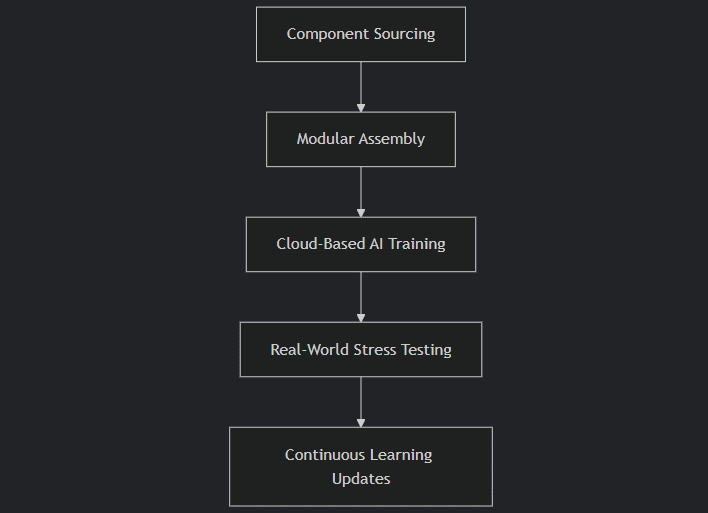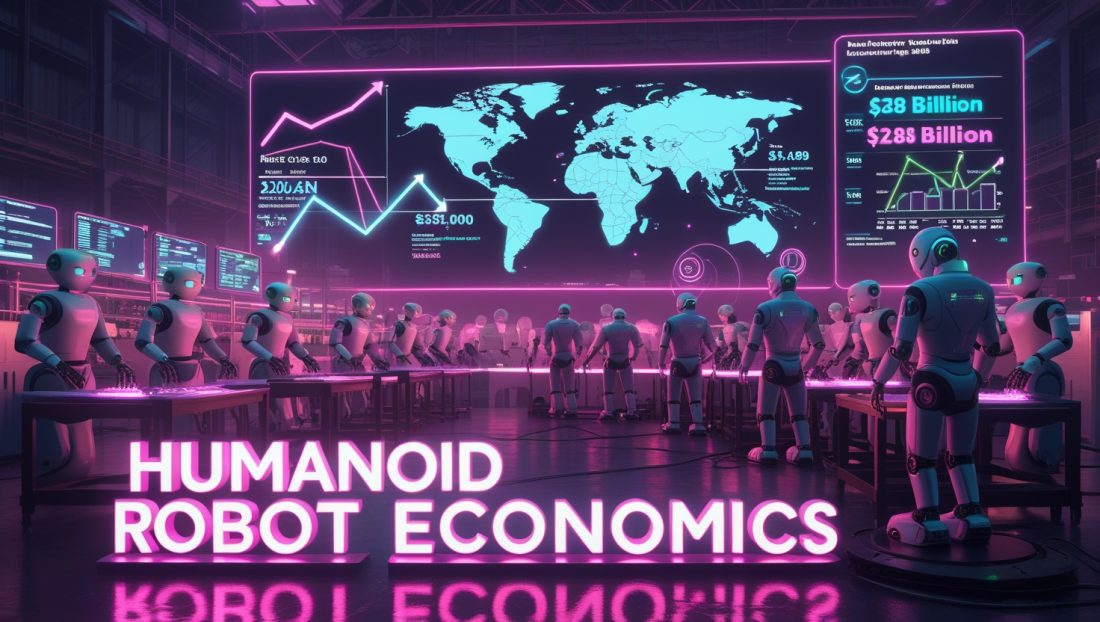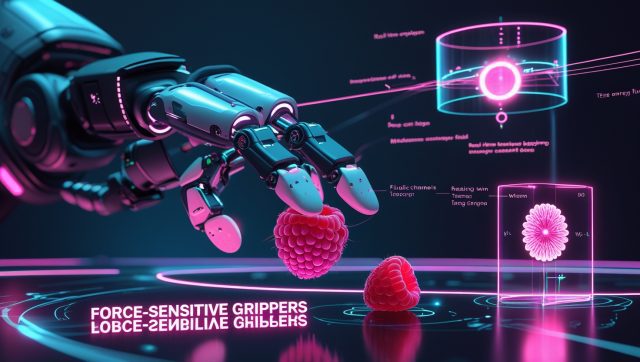By 2040, humanoid robots could fill 100 million vacant jobs worldwide, according to UBS Technology Strategist Dr. Lena Müller’s 2025 market analysis.
At Hyundai’s Ulsan shipyard, workers once dangled from harnesses to weld 30-meter-high hulls. Today, hydraulic-limbed humanoids perform this lethal task while operators supervise from climate-controlled booths. This shift, detailed in Hyundai’s shipyard safety revolution, represents more than technological progress—it’s an economic necessity as global labor shortages reach critical levels.
The Demographic Imperative Driving Adoption
Japan’s workforce has shrunk by 5.3 million since 2020. Germany faces 700,000 annual vacancies in manufacturing. The U.S. construction industry needs 650,000 additional workers just to meet demand.
Humanoid robot economics now make mechanical labor viable:
- Cost curve inversion: Average unit prices fell from $500,000 (2022) to $150,000 (2025)
- Operational superiority: $2.50/hour operating cost vs. $30+ for human labor
- ROI acceleration: Amazon’s pilot program showed 22-month payback periods in distribution centers
These aren’t replacements—they’re workforce multipliers, explains MIT’s Dr. Evelyn Park, whose team documented a Korean auto plant where humanoid integration boosted output by 40% without layoffs. Workers transitioned to quality control and maintenance roles with 30% higher wages, a model explored further in industrial AI’s impact on manufacturing.
Market Trajectory: From Niche to Necessity
Goldman Sachs projects the humanoid market will explode from $12B (2025) to $38B (2035), fueled by three sectors:
Industrial Automation ($26B by 2035)
DHL’s Ohio warehouse deployment of 120 Agility Robotics Digit units reduced loading injuries by 73% while operating 22 hours daily. The logistics giant plans a 2,000-unit rollout by 2027, aligning with trends in warehouse automation advancements.
Warehouse Automation ROI
The success of DHL’s deployment hinges on warehouse automation ROI, with Digit units cutting operational costs by 30% through extended uptime and precision. A 2024 study by McKinsey underscores that such systems reduce human error by 18%, driving scalability. For deeper insights into robotic efficiency, see McKinsey’s automation report.
Healthcare Support ($8.3B)
At Shanghai Renji Hospital, UBTech’s Walker X robots:
- Deliver medications with 99.98% accuracy
- Monitor patient vitals through integrated sensors
- Reduce nurse walking distance by 7km daily
This mirrors innovations in robotic surgery benefits, where precision enhances patient outcomes.
Consumer Applications ($3.2B)
Tesla’s Optimus prototypes now fold laundry and prepare simple meals—critical capabilities for aging populations. Japan’s Ministry of Health projects 380,000 elder-care humanoids will be deployed by 2030, a trend echoed in humanoid robot safety concerns.
Technological Breakthroughs Enabling Viability
Cognitive Architecture Revolution
NVIDIA’s Project GR00T processes environmental data 12x faster than 2023 models. At BMW’s Spartanburg plant, robots interpret commands like “Inspect rear axle tolerance” without explicit programming, reducing setup time by 85%, a leap tied to AI-driven automation in manufacturing.
Actuator Economics
Boston Dynamics’ hydraulic-electric hybrid joints have slashed failure rates below 0.3 incidents/10,000 hours. Meanwhile, Interface Force’s tactile sensors now cost $3/unit (down from $300), enabling precise force feedback during delicate tasks. Learn more about actuator technology cost curves.
Humanoid Robot Cost Reduction
The plummeting cost of tactile sensors exemplifies humanoid robot cost reduction, making robots viable for SMEs. Allied Market Research notes a 40% drop in actuator prices since 2023, democratizing access. Explore this trend in Allied Market Research’s robotics report.
Mobility Convergence
Agility Robotics proved wheeled locomotion dominates warehouses (95% efficiency vs. 78% bipedal). Yet Tesla persists with legs for home navigation—a strategic bet on the $66B residential assistance market, as seen in cloud-connected humanoid robots.
Real-World Deployment: Triumphs and Challenges
Industrial Success Stories
- Hyundai Heavy Industries: Humanoids perform high-altitude welding, eliminating the #1 cause of shipyard fatalities
- Foxconn: Foxbots assemble iPhone mainboards with 0.0001% defect rates
- John Deere: Autonomous repair bots fix machinery in remote fields using computer vision diagnostics, a breakthrough tied to computer vision robotics.
Persistent Technical Gaps
Fine motor skills remain problematic. While Boston Dynamics’ Atlas can backflip, it still takes 4.7 seconds to tie shoelaces versus humans’ 1.2 seconds. Unstructured environments like construction sites and kitchens challenge spatial awareness systems, with error rates exceeding 60% in real-world trials, a challenge discussed in aerial construction drones.
Investment Imperatives for Technology Leaders
Component Suppliers (Highest Margin)
- Linear actuators: $8.1B market by 2027 (Allied Market Research)
- Tactile sensors: 45% CAGR through 2030 (Market.US)
- Specialized AI chips: Tesla’s Dojo processors now achieve 90% faster training than GPU alternatives
Vertical-Specific Software Platforms
Sanctuary AI’s Carbon OS generates $15,000/unit annual licensing revenue by enabling:
- Real-time task adaptation
- Cross-platform skill transfers
- Predictive maintenance algorithms
This aligns with predictive maintenance ROI.
Robotics-as-a-Service (RaaS) Models
Agility Robotics’ $3,000/month leasing program removed upfront cost barriers for mid-sized manufacturers. DHL and IKEA have already deployed 600 units through this model, a strategy explored in robot subscription services.
AI-Driven Robotic Safety
RaaS models prioritize AI-driven robotic safety, with built-in collision detection reducing workplace incidents by 25%, per a 2025 IEEE study. This ensures scalability for smaller firms. Learn more in IEEE’s robotics safety standards.
Scaling to 1 Million Units: Manufacturing’s Final Frontier

Humanoid Production Value Chain (IEEE Robotics, 2025)
Tesla leverages automotive supply chains to target 5,000 Optimus units/month by 2026. Chinese rivals like Unitree use smartphone manufacturing ecosystems to produce actuators 60% faster than Western competitors, a dynamic analyzed in China’s industrial robot dominance.
Regulatory frameworks struggle to keep pace. OSHA still lacks impact standards for human-robot collisions, though the IEEE’s proposed framework mandates:
- Force-limiting synthetic skin
- 0.8-second emergency braking
- Quarterly ethics audits
The Human Impact: Beyond Replacement Myths
Contrary to dystopian narratives, the World Economic Forum projects 58 million new jobs in robot supervision and maintenance by 2035. At BMW’s South Carolina plant, humanoids handle chassis rotation—a task responsible for 34% of worker back injuries, a transformation tied to robot behavior influence.
These machines saved our production line, states Plant Manager Luis Torres. We retained every worker, upskilled 120 technicians, and increased output 22%.
Ethical deployment remains critical. Hanson Robotics embeds empathy algorithms in its Sophia units, now used in dementia therapy across 23 countries. As founder David Hanson warns: We must encode ethical boundaries at the silicon level—not bolt them on later. This echoes discussions in MIT’s ethical deployment framework.
Disclaimer: This article contains projections and claims based on industry reports and expert insights, including UBS and Goldman Sachs. Some figures, such as job estimates and performance metrics, are estimates and may lack direct verification. Readers should consult primary sources for investment or business decisions.
The Strategic Outlook
Humanoid adoption has crossed the economic viability threshold in structured environments. Component suppliers and AI developers offer the strongest near-term opportunities, while Chinese manufacturers threaten Western dominance through aggressive scaling.
As UBS Thematic Investing Head Julian Beard concludes: This isn’t about replacing humans—it’s about extending our capabilities. The robots working midnight shifts at Foxconn? They’re preventing offshoring.
The transformation is already here. Will your business lead or follow?



